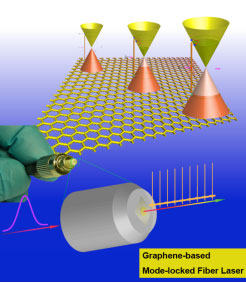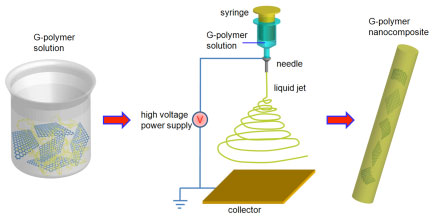| Posted: Jan 06, 2010 | |
The rise of graphene in ultra-fast photonics |
|
| (Nanowerk Spotlight) A group of researchers from Singapore, led by Professor Dingyuan Tang from Nanyang Technological University and Professor Kian Ping Loh from National University of Singapore, reported the first breakthrough in using few-layer graphene as a saturable absorber for the mode locking of lasers. Despite its prominent mechanical and electrical properties, graphene’s optical response has previously been considered to be weak and featureless, so the main interests of the research community are centered on its electronics properties. But now, Tang and Loh demonstrate that graphene can be used for telecommunications applications and that its weak and universal optical response might be turned into advantages for ultrafast photonics applications. | |
| Unlike conventional semiconductors materials, the valence band and conduction band in graphene are smooth-sided cones that meet at a point – called the Dirac point – and graphene has no energy band-gap and readily absorb all photons at any wavelength. But if incident light intensity becomes strong enough, due to the Pauli blocking principle, the generated carriers fill the valence bands, preventing further excitation of electrons at valance band and allowing photons transmitted absence of loss, as shown in Fig.1. This is an indication that graphene could be potentially exploited as a saturable absorber with wide optical response ranging from ultra-violet, visible, infrared to terahertz. | |
 |
|
| Fig. 1: Schematic excitation process responsible for saturable absorption of light in graphene and Schematic operation principle of graphene-based saturable absorber which locked modes and turned CW into pulses. | |
| In a laser cavity, the ‘cavity’ of a laser ensures that light is emitted at well-defined wavelengths, known as modes. These modes naturally oscillate in time, each with a different phase, and the superposition of multiple modes results in a constant output known as continuous-wave laser light. By introducing a saturable absorber into the cavity, modes with stronger intensity will be selected while modes with weaker intensity will be suppressed; eventually, after millions of circulation in the cavity, all modes with strongest intensity can be made to oscillate in phase, giving rise to short and very intense light pulses. Correspondingly, a saturable absorber, that is, its light absorbance decreases rapidly with increasing light intensity – an essential property for passive laser mode lockers. | |
| "Since we first experimentally verify graphene’s saturable absorption property, graphene-based ultra-fast saturable absorber devices were immediately developed to passively mode lock lasers with wide-band tunable central wavelength," Tang tells Nanowerk. "What’s more, laser performance, such as high power emission, was largely improved as a consequence of graphene’s weak optical response." | |
| Tang’s exciting findings appears to be graphene’s first ultra-fast photonic application and has already attracted much attention and aroused enthusiasm from the quantum electronics, ultra-fast photonics and nanoscience research communities. | |
| Tang also points out that the addition of a layering structure could tune graphene’s electronics properties, thus influencing its photonics nature as well as its saturable absorption property – related to the mode locking behavior – demonstrating that the laser performance could be effortlessly controlled by this approach ("Atomic-Layer Graphene as a Saturable Absorber for Ultrafast Pulsed Lasers" and "Large energy mode locking of an erbium-doped fiber laser with atomic layer graphene"). | |
| From the perspective of a laser expert, Tang was amazed at graphene’s tunable photonic property and believes that this astonishing feature will guarantee graphene with brilliant photonic application given that the ability to extensively control and tune materials' properties is now at the center of modern photonics. | |
| According to Tang’s collaborator Loh, “the chemical modification of graphene could bring completely new physics.” Determined by the nature of chemical dopants and how they are introduced into the graphene lattice – adsorption, substitution, or intercalation – all these can induce significant change of graphene’s electronics properties: affecting the carrier density concentration and shifting Fermi level, which finally affects graphene’s photonic properties. | |
| One recent example of chemically doping graphene approached by this team is introducing a graphene–polymer composite film into an erbium-doped fiber laser. Fig.2 shows the schematic illustration of the fabrication of graphene-polymer nanofiber composite by electro-spinning. | |
| “Encapsulating graphene in the polymer host passivates the graphene from ambient oxygen, which prevents photo-oxidation and optical bleaching by high-powered lasers,” says Tang. | |
| The researchers observed efficient mode locking with pulses as short as 700 fs at a wavelength of 1590 nm with pulse energy of 3 nJ. These characteristics surpass those achieved by the same laser using other types of mode lockers such as carbon nanotubes and semiconductor saturable absorber mirrors. Furthermore, careful examination of the pulse shape revealed that the pulse was composed of one soliton — a nonlinear localized wave. This is a major improvement compared with standard mode lockers, which usually give rise to multiple solitons ("Large energy soliton erbium-doped fiber laser with a graphene-polymer composite mode locker"). | |
 |
|
| Fig. 2: Schematic illustration of the fabrication of graphene-polymer nanofiber composite by electrospinning. | |
| The results represent a real advance in photonics applications of graphene. | |
| Tang summarizes the remarkable advantages of graphene's wavelength-independent saturable absorption features: "(i) weak non-saturable scattering loss due to graphene’s 2-dimensional structure; (ii) tuneable saturable absorption properties through controlling the number of graphene’s layers or through chemical functionalization; (iii) two dimensional sheet structure, free from bundling or entangling, unlike SWCNTs; (iv) high damage threshold and the absence of two photon absorption, warranting the formation of large energy ultra-short pulse; (v) universal saturable absorption property ensuring the wideband tunable mode locking." | |
| “So far, the exploration of graphene’s ultra-fast photonics application is ongoing and continuously rising, far from mature,"Tang and Loh conclude. "This pioneering research can deepen our understanding of graphene’s photonics properties, which might in turn benefit the unveiling of graphene’s peculiar electronic dynamics and thus bright up more exciting physics and, possibly, even wider-ranging applications. It is envisaged that many new photonic properties of graphene will be discovered, and new concepts on graphene based ultra-fast photonic devices will emerge. It definitely paves the way to graphene based ultra-fast photonics applications for ultra-fast micro-processing, bio-medical, sensing, military and telecommunications systems.” | |
| By Han Zhang, Nanyang Technological University. Copyright Nanowerk | |
|
Become a Spotlight guest author! Join our large and growing group of guest contributors. Have you just published a scientific paper or have other exciting developments to share with the nanotechnology community? Here is how to publish on nanowerk.com. |
|
